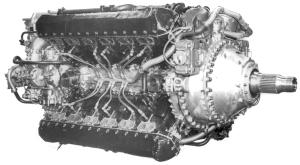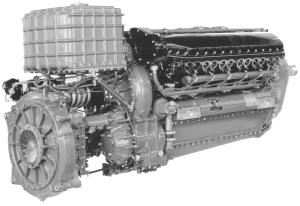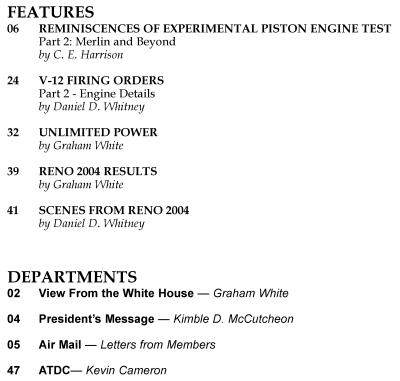
Torque Meter
Fall 2004 Issue
 |
 The X-24 Vulture |
Reminiscences of Experimental Piston Engine Tests, Part 2 "A recurrent problem on test [of the Vulture] was due to the disposition of the lower banks of cylinders; they were below the main 6 inch cast iron trunks leading to the test house silencers. In the interests of durability and silence a stream of water was injected downstream into the exhaust just aft of the No 6 stubs and of course the lower 12 cylinders were below the level of the water injected after the upper twelve. When the engine was not running the water could run back into the lower exhaust ports. If any one of the four valves controlling this injected water was not completely closed on shut down the lower banks would become water logged and the prospect of hydraulic lock and expensive noises was very high. During one spell when I was on the 8:00 pm to 8:00 am night shift, several times I had to remove all 24 bottom plugs, dry them and then motor the engine to blow out any water left in the cylinders. On refitting the plugs chances were that at least one and possibly more would pick up drops of water that remained in the combustion chambers. This meant that you had to run the engine on single ignition while wiping the stubs with an oily rag and checking which ones did not burn it off. Repeating with the other magneto switched off. The ’wet’ plugs would then have to be removed, dried and replaced so that the day shift could get a clean start at 8:00am. Due to the time consuming nature of this work I decided to remove all 24 bottom plugs and after a few revs motoring, fire up the engine on the top 12 cylinders when all the water was completely blown out to the accompaniment of very peculiar noises. All 12 bottom cylinders would fire 100% when the plugs were replaced. That one never got in the log book." This is the account of Chris Harrison, a Rolls-Royce engine tester, who saw them all, from the "R" racing engine to the amazing Crecy. |
|
V-12 Firing Orders, Part 2 Most people look at tabulated V-12 firing orders with a degree of confusion and dismay. Not only does it first appear that the 12 cylinder sequence is random, the nomenclature often obstructs by introducing numbering schemes and letters such as A, B, L, R, D, G to describe the left and right banks. Also, manufacturers use different references as to the location of number one cylinder, it maybe either next to the propeller, or on the anti-propeller end. And of course the engine might be either upright or inverted! In an effort to make V-12 firing orders comparable, the author uses a naming convention adapted from the German V-12 manufacturers. Beginning at the propeller, cylinders 1-6 are in the right bank, and 7-12 on the left. This applies whether the engine is upright or inverted. With this convention it is also necessary to know the direction of rotation of the crankshaft, either CW or CCW as viewed from the anti-propeller end, looking toward the propeller. This resolves the complexity of direct drive, or geared, and removes confusion caused by the characteristics of different types of gear systems, such as internal or external spur gears, or epicyclic. Note that engine data plates typically use a propitiatory manufacturer nomenclature, as well as describing only the direction of propeller rotation. Firing orders used by historically significant V-12s are discussed. Some of the most interesting are presented diagrammatically. The AEHS has produced an On-Line Version to present this information. |
 |
Unlimited Power Watching Unlimited Class racers blast around the pylons at what appears to be warp speed makes you wonder; what on earth powers these remarkable aircraft? It turns out to be engines developed over 60 years ago, most of which played a significant role in the Allied victory in World War II. Companies such as Rolls-Royce, Packard, Pratt & Whitney and Wright Aeronautical Corporation were household names. Only Rolls-Royce and Pratt & Whitney have survived to the modern era. The greatest minds and top graduates of the best universities in the world were put to work designing what would turn out to be the ultimate hot rods.
|
